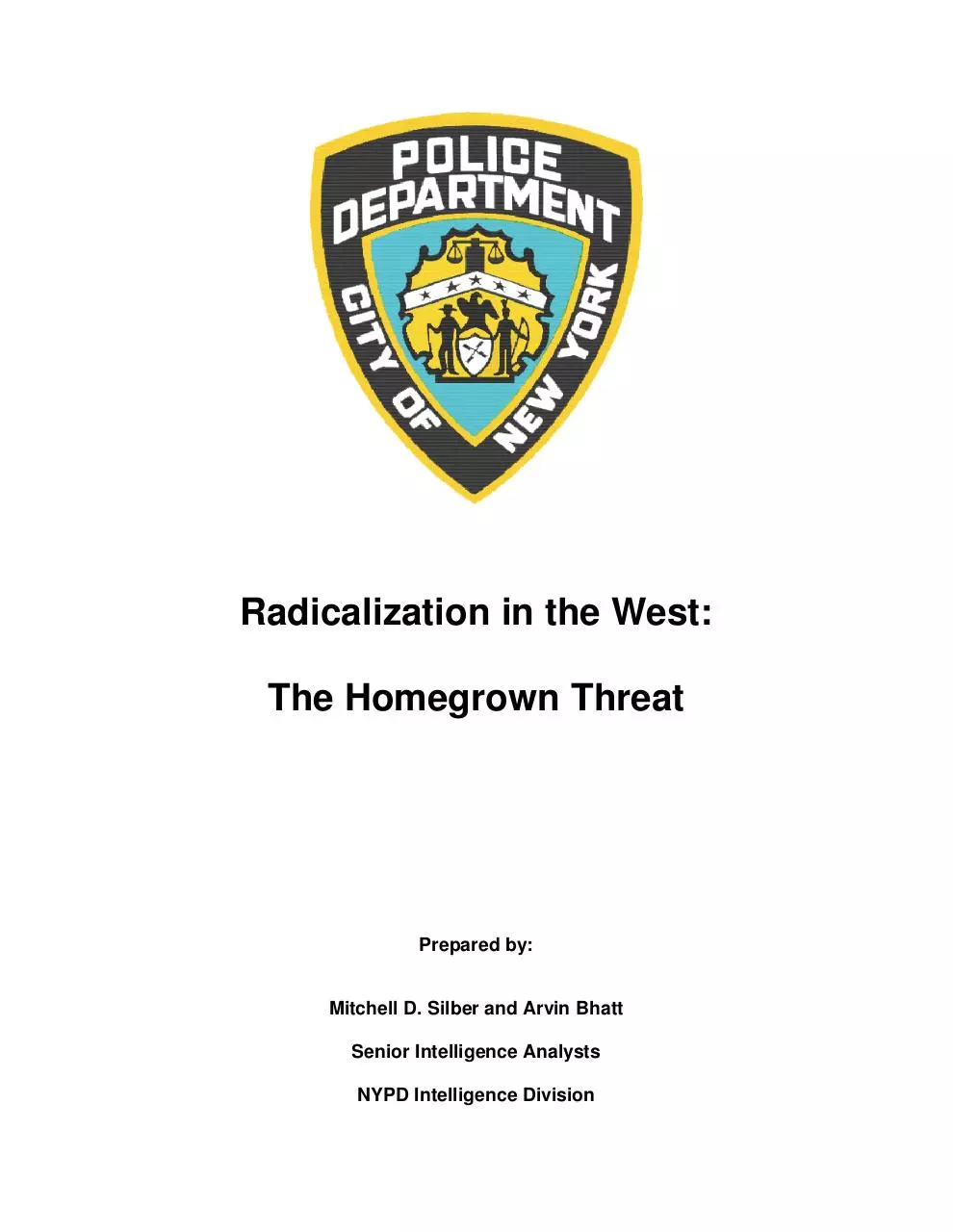NYPD Report Radicalization in the West (PDF)
File information
Title: Microsoft Word - final mono2.doc
Author: CCS
This PDF 1.4 document has been generated by PScript5.dll Version 5.2 / GPL Ghostscript 8.15, and has been sent on pdf-archive.com on 18/01/2016 at 23:01, from IP address 72.74.x.x.
The current document download page has been viewed 666 times.
File size: 2.2 MB (90 pages).
Privacy: public file





File preview
Radicalization in the West:
The Homegrown Threat
Prepared by:
Mitchell D. Silber and Arvin Bhatt
Senior Intelligence Analysts
NYPD Intelligence Division
The New York City Police Department
Page 2
PREFACE
While terrorism has been with us for centuries, the destructive power and global reach of
modern terrorism is unprecedented. The entire world witnessed the attacks of
September 11, 2001, but most of the attacks and attempted attacks since then have
shown 9/11 to be an anomaly rather than the standard pattern for terrorism in the
homeland.
If the post-September 11th world has taught us anything, it is that the tools for conducting
serious terrorist attacks are becoming easier to acquire. Therefore intention becomes
an increasingly important factor in the formation of terrorist cells. This study is an
attempt to look at how that intention forms, hardens and leads to an attack or attempted
attack using real world case studies.
While the threat from overseas remains, many of the terrorist attacks or thwarted plots
against cities in Europe, Canada, Australia and the United States have been
conceptualized and planned by local residents/citizens who sought to attack their
country of residence. The majority of these individuals began as “unremarkable” - they
had “unremarkable” jobs, had lived “unremarkable” lives and had little, if any criminal
history. The recently thwarted plot by homegrown jihadists, in May 2007, against Fort
Dix in New Jersey, only underscores the seriousness of this emerging threat.
Understanding this trend and the radicalization process in the West that drives
“unremarkable” people to become terrorists is vital for developing effective counterstrategies. This realization has special importance for the NYPD and the City of New
York. As one of the country’s iconic symbols and the target of numerous terrorist plots
since the 1990’s, New York City continues to be the one of the top targets of terrorists
worldwide. Consequently, the NYPD places a priority on understanding what drives and
defines the radicalization process.
The aim of this report is to assist policymakers and law enforcement officials, both in
Washington and throughout the country, by providing a thorough understanding of the
kind of threat we face domestically. It also seeks to contribute to the debate among
intelligence and law enforcement agencies on how best to counter this emerging threat
by better understanding what constitutes the radicalization process.
Raymond W. Kelly
Police Commissioner of the City of New York
The New York City Police Department
Page 3
The New York City Police Department
Page 4
Table of Contents
Executive Summary…………………………………………………………………...Page 5
The Threat……………………………………………………………………………...Page 14
Radicalization: Western Style………………………………………………………...Page 16
The Radicalization Process…………………………………………………………..Page 19
Radicalization in the West: Five Foreign Cases……………………………………Page 21
Pre-Radicalization…………………………………………………………….Page 22
Self-Identification……………………………………………………………..Page 30
Indoctrination………………………………………………………………….Page 36
Jihadization……………………………………………………………………Page 43
Radicalization in the United States………………………………………………… Page 55
The New York City Experience………………………………………………………Page 66
September 11 Revisited………………………………………………………………Page 76
Findings and Implications……………………………………………………………..Page 82
Glossary of Terms……………………………………………………………………..Page 86
Endnotes………………………………………………………………………………..Page 87
Copyright © 2007 New York City Police Department. All Rights Reserved.
The New York City Police Department
Page 5
EXECUTIVE SUMMARY
The NYPD’s understanding of the threat from Islamic-based terrorism to New York City
has evolved since September 11, 2001. While the threat from overseas remains,
terrorist attacks or thwarted plots against cities in Europe, Australia and Canada since
2001 fit a different paradigm. Rather than being directed from al-Qaeda abroad, these
plots have been conceptualized and planned by “unremarkable” local residents/citizens
who sought to attack their country of residence, utilizing al-Qaeda as their inspiration
and ideological reference point.
Some of these cases include:
•
•
•
•
•
Madrid’s March 2004 attack
Amsterdam’s Hofstad Group
London’s July 2005 attack
Australia’s Operation Pendennis (which thwarted an attack(s) in November 2005)
The Toronto 18 Case (which thwarted an attack in June 2006)
Where once we would have defined the initial indicator of the threat at the point where a
terrorist or group of terrorists would actually plan an attack, we have now shifted our
focus to a much earlier point—a point where we believe the potential terrorist or group of
terrorists begin and progress through a process of radicalization. The culmination of this
process is a terrorist attack.
Understanding this trend and the radicalization process in the West that drives
“unremarkable” people to become terrorists is vital for developing effective counterstrategies and has special importance for the NYPD and the City of New York. As one
of the country’s iconic symbols and the target of numerous terrorist plots since the
1990’s, New York City continues to be among the top targets of terrorists worldwide.
In order to test whether the same framework for understanding radicalization abroad
applied within the United States, we analyzed three U.S. homegrown terrorism cases
and two New York City based cases:
•
•
•
•
•
Lackawana, New York
Portland, Oregon
Northern Virginia
New York City - Herald Square Subway
New York City – The Al Muhajiroun Two
The same radicalization framework was applied to a study of the origins of the Hamburg
cluster of individuals, who led the September 11 hijackers. This assessment, almost six
years after 2001, provides some new insights, previously not fully-grasped by the law
enforcement and intelligence community, into the origins of this devastating attack.
The New York City Police Department
Page 6
RADICALIZATION
Ideology
Jihadist or jihadi-Salafi ideology is the driver that motivates young men and women, born
or living in the West, to carry out “autonomous jihad” via acts of terrorism against their
host countries. It guides movements, identifies the issues, drives recruitment and is the
basis for action.
•
This ideology has served as the inspiration for numerous homegrown groups
including the Madrid March 2004 bombers, Amsterdam’s Hofstad Group,
London’s July 2005 bombers, the Australians arrested as part of Operation
Pendennis in late 2005 and the Toronto 18 arrested in June 2006.
Process
An assessment of the various reported models of radicalization leads to the conclusion
that the radicalization process is composed of four distinct phases:
•
•
•
•
Stage 1: Pre-Radicalization
Stage 2: Self-Identification
Stage 3: Indoctrination
Stage 4: Jihadization
o
o
o
o
o
Each of these phases is unique and has specific signatures
All individuals who begin this process do not necessarily pass through all the
stages
Many stop or abandon this process at different points
Although this model is sequential, individuals do not always follow a perfectly
linear progression
Individuals who do pass through this entire process are quite likely to be
involved in the planning or implementation of a terrorist act
PHASES OF RADICALIZATION
PRE-RADICALIZATION. Pre-Radicalization is the point of origin for individuals before
they begin this progression. It is their life situation before they were exposed to and
adopted jihadi-Salafi Islam as their own ideology.
•
The majority of the individuals involved in these plots began as “unremarkable” they had “ordinary” jobs, had lived “ordinary” lives and had little, if any criminal
history.
SELF-IDENTIFICATION. Self-Identification is the phase where individuals, influenced
by both internal and external factors, begin to explore Salafi Islam, gradually gravitate
away from their old identity and begin to associate themselves with like-minded
individuals and adopt this ideology as their own. The catalyst for this “religious seeking”
is a cognitive opening, or crisis, which shakes one’s certitude in previously held beliefs
and opens an individual to be receptive to new worldviews.
The New York City Police Department
Page 7
There can be many types of triggers that can serve as the catalyst including:
•
•
•
•
Economic (losing a job, blocked mobility)
Social (alienation, discrimination, racism – real or perceived)
Political (international conflicts involving Muslims)
Personal (death in the close family)
INDOCTRINATION. Indoctrination is the phase in which an individual progressively
intensifies his beliefs, wholly adopts jihadi-Salafi ideology and concludes, without
question, that the conditions and circumstances exist where action is required to support
and further the cause. That action is militant jihad. This phase is typically facilitated and
driven by a “spiritual sanctioner”.
•
While the initial self-identification process may be an individual act, as noted
above, association with like-minded people is an important factor as the process
deepens. By the indoctrination phase this self-selecting group becomes
increasingly important as radical views are encouraged and reinforced.
JIHADIZATION. Jihadization is the phase in which members of the cluster accept their
individual duty to participate in jihad and self-designate themselves as holy warriors or
mujahedeen. Ultimately, the group will begin operational planning for the jihad or a
terrorist attack. These “acts in furtherance” will include planning, preparation and
execution.
•
While the other phases of radicalization may take place gradually, over two to
three years, this jihadization component can be a very rapid process, taking only
a few months, or even weeks to run its course.
FINDINGS
•
Al-Qaeda has provided the inspiration for homegrown radicalization and
terrorism; direct command and control by al-Qaeda has been the exception,
rather than the rule among the case studies reviewed in this study.
•
The four stages of the radicalization process, each with its distinct set of
indicators and signatures, are clearly evident in each of the nearly one dozen
terrorist-related case studies reviewed in this report.
•
o
In spite of the differences in both circumstances and environment in each of
the cases, there is a remarkable consistency in the behaviors and trajectory
of each of the plots across all the stages.
o
This consistency provides a tool for predictability.
The transnational phenomenon of radicalization in the West is largely a function
of the people and the environment in which they live. Much different from the
Israeli-Palestinian equation, the transformation of a Western-based individual to
a terrorist is not triggered by oppression, suffering, revenge, or desperation.
The New York City Police Department
Page 8
•
Rather, it is a phenomenon that occurs because the individual is looking for an
identity and a cause and unfortunately, often finds them in the extremist Islam.
•
There is no useful profile to assist law enforcement or intelligence to predict who
will follow this trajectory of radicalization. Rather, the individuals who take this
course begin as “unremarkable” from various walks of life.
•
Europe’s failure to integrate the 2nd and 3rd generation of its immigrants into
society, both economically and socially, has left many young Muslims torn
between the secular West and their religious heritage. This inner conflict makes
them especially vulnerable to extremism—the radical views, philosophy, and
rhetoric that is highly advertised and becoming more and more fashionable
among young Muslims in the West.
•
Muslims in the U.S. are more resistant, but not immune to the radical message.
o
•
The jihadist ideology combines the extreme and minority interpretation [jihadiSalafi] of Islam with an activist-like commitment or responsibility to solve global
political grievances through violence. Ultimately, the jihadist envisions a world in
which jihadi-Salafi Islam is dominant and is the basis of government.
o
•
Despite the economic opportunities in the United States, the powerful
gravitational pull of individuals’ religious roots and identity sometimes
supersedes the assimilating nature of American society which includes
pursuit of a professional career, financial stability and material comforts.
This ideology is proliferating in Western democracies at a logarithmic rate.
The Internet, certain Salafi-based NGO’s (non-governmental
organizations), extremist sermons /study groups, Salafi literature, jihadi
videotapes, extremist - sponsored trips to radical madrassas and militant
training camps abroad have served as “extremist incubators” for young,
susceptible Muslims -- especially ones living in diaspora communities in the
West.
The Internet is a driver and enabler for the process of radicalization
o
In the Self-Identification phase, the Internet provides the wandering mind of
the conflicted young Muslim or potential convert with direct access to
unfiltered radical and extremist ideology.
o
It also serves as an anonymous virtual meeting place—a place where
virtual groups of like-minded and conflicted individuals can meet, form
virtual relationships and discuss and share the jihadi-Salafi message they
have encountered.
o
During the Indoctrination phase, when individuals adopt this virulent
ideology, they begin interpreting the world from this newly-formed context.
Cloaked with a veil of objectivity, the Internet allows the aspiring jihadist to
view the world and global conflicts through this extremist lens, further
The New York City Police Department
Page 9
reinforcing the objectives and political arguments of the jihadi-Salafi
agenda.
o
•
Individuals generally appear to begin the radicalization process on their own.
Invariably, as they progress through the stages of radicalization they seek likeminded individuals. This leads to the creation of groups or clusters. These
clusters appear almost essential to progressing to the Jihadization stage—the
critical stage that leads to a terrorist act.
o
•
•
In the Jihadization phase, when an individual commits to jihad, the Internet
serves as an enabler—providing broad access to an array of information on
targets, their vulnerabilities and the design of weapons.
“Group think” is one of the most powerful catalysts for leading a group to
actually committing a terrorist act. It acts as a force-multiplier for radical
thought while creating a competitive environment amongst the group
members for being the most radical.
Although there are many groups or clusters of individuals that are on the path of
radicalization, each group needs certain archetypes to evolve from just being a
“bunch of guys” to an operational terrorist cell. All eleven case studies had:
o
A “spiritual sanctioner” who provides the justification for jihad—a
justification that is especially essential for the suicide terrorist. In some
cases the sanctioner was the nucleus around which the cluster formed.
o
An “operational leader” who is essential as the group decides to conduct a
terrorist act--organizing, controlling and keeping the group focused and its
motivation high.
The full radicalization of a Western individual, or groups of individuals, does not
always result in the committing of a terrorist act in the West. Many fullyradicalized individuals have first looked to conduct jihad by becoming
mujahedeen and fighting in conflicts overseas.
o
The image of the heroic, holy warrior or “mujahedeen” has been widely
marketed on the Internet as well as in jihadi tapes and videos. This image
continues to resonate among young, especially Muslim, men 15-35 yearsold—men who are most vulnerable to visions of honor, bravery and
sacrifice for what is perceived as a noble cause.
o
Among those individuals who travel abroad in search of jihad, some end up
as mujahedeen and fight in foreign lands; some are re-directed to commit
acts in the West, often in their country of origin, while others give up and
return home because they can’t endure the training or have a change of
heart.
Download NYPD Report-Radicalization in the West
NYPD_Report-Radicalization_in_the_West.pdf (PDF, 2.2 MB)
Download PDF
Share this file on social networks
Link to this page
Permanent link
Use the permanent link to the download page to share your document on Facebook, Twitter, LinkedIn, or directly with a contact by e-Mail, Messenger, Whatsapp, Line..
Short link
Use the short link to share your document on Twitter or by text message (SMS)
HTML Code
Copy the following HTML code to share your document on a Website or Blog
QR Code to this page

This file has been shared publicly by a user of PDF Archive.
Document ID: 0000333233.